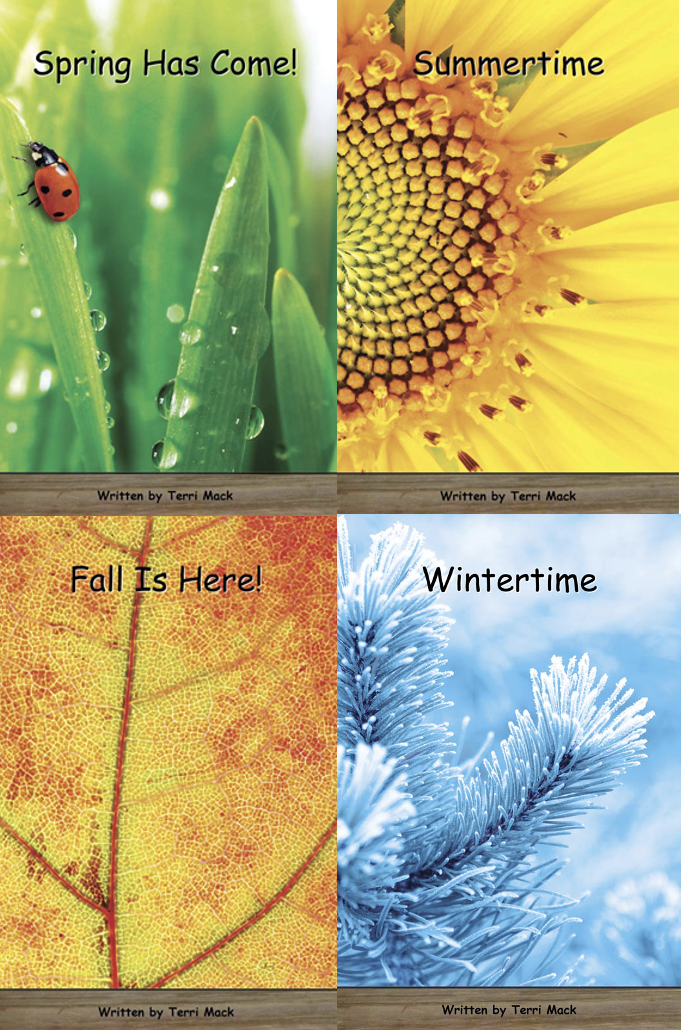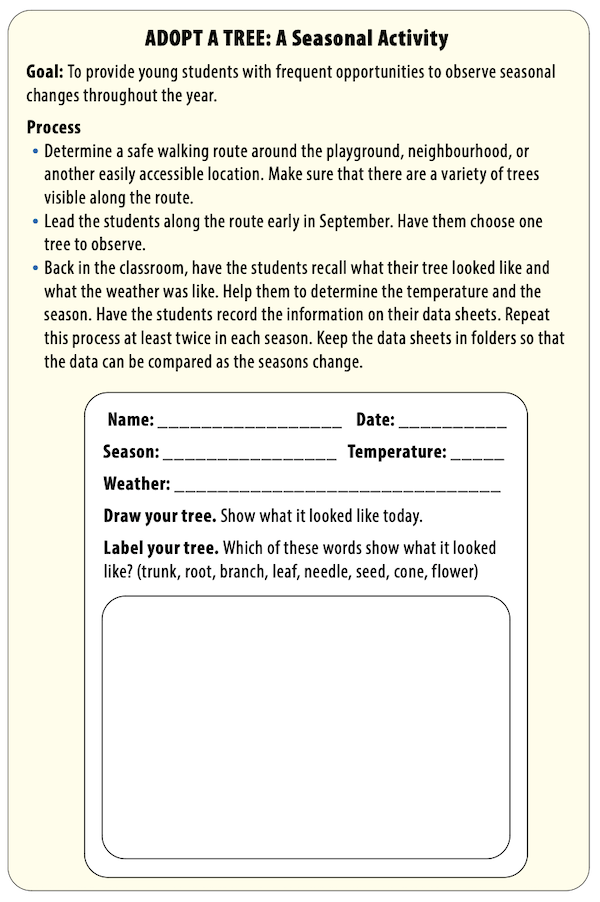sea•son (noun): each of the four divisions of the year (spring, summer, autumn, and winter) marked by particular weather patterns and daylight hours, resulting from the earth’s changing position with regard to the sun. Oxford Languages
By observing their environment, young students become aware of the many physical changes that occur throughout the year. Changes in temperature, weather, and light can elicit a variety of responses from the local plants and animals and alter human behaviours as well. Students also come to recognize that changes can occur in cycles—short cycles such as day and night, and longer cycles such as the seasonal changes.
“Seasonal Changes” is a topic that is included in most primary grade curricula. There are many wonderful books and resources that would support an integrated unit of study that could include literature, science, and social studies
learning outcomes. Here are just a few.
Books That Introduce Seasonal Change
 We Share the Seasons
We Share the Seasons
by Brenda Boreham and Terri Mack illustrated by Bill Helin
Strong Nations Publishing
ISBN 9781771741026
16 pages, ages 6 – 7
strongnations.com
We Share the Seasons is part of the From the Mountains to the Sea series of books for primary-grade students. This book describes the changing seasons in and along a riverbank that runs from the mountains down to the sea. The content highlights the interconnectedness of all things within an ecosystem and includes science and social studies content with a focus on Indigenous peoples’ perspectives.
 Spring Has Come!
Spring Has Come!
Summertime
Fall is Here!
Wintertime
by Terri Mack
Strong Nations Publishing
ISBN 9781771740296
ISBN 9781771740173
ISBN 9781771740203
ISBN 9781771740265
16 pp, ages 6 – 7
strongnations.com
These four titles introduce young readers to some terminology (names of the seasons, names of the months) and discuss some of the attributes of each of the seasons. Written in lyrical, rhyming verse, these colourful books provide multiple opportunities for students to make connections and ask questions.
 Wolf Island
Wolf Island
written and illustrated by Celia Godkin
Fitzhenry and Whiteside
ISBN 9781554550081
36 pages, ages 6 – 8
fitzhenry.ca
Set on a small island in Ontario, this award-winning picture book tells the story of what happens when the top link of a food chain is lost. The resulting population growth of the remaining species, the ensuing food shortages and consequent starvation, take place over the next two years. The multiple changes of season are mentioned in the text and described in the colourful pencil crayon illustrations. During the second winter, the wolf family finds its way back to the island and the ecosystem returns to balance.
Books That Support Seasonal Change Thematic Units
WINTER
 Fox on the Ice
Fox on the Ice
by Tomson Highway
Fifth House Publishers
ISBN 9781897252666
32 pages, ages 6 – 8
fifthhousepublishers.ca
Written in two languages (Cree/ English or Cree/French) Fox on the Ice tells the story of two young brothers who were on an ice fishing trip with their parents. When the story begins, Cody is helping their father with the fishing while Joe and their mother are napping on the sled. Suddenly, the sled dogs stand up and sniff the air. They have spotted a red fox across the lake! What follows is a very bumpy ride for Joe and their mother as the dogs pursue the fox.
Note: A free, downloadable lesson plan is available at: strongnations.com
SPRING
 Garden Wonders: A Guidebook for Little Green Thumbs written and illustrated by Sarah Grindler Nimbus Publishing
Garden Wonders: A Guidebook for Little Green Thumbs written and illustrated by Sarah Grindler Nimbus Publishing
ISBN 9781774711439
32 pages, ages 5 – 8
nimbus.ca
Whether your school has a big garden plot or you are planning to have your students grow bulbs along the classroom window ledge, you can grow almost anything with water, soil, and sunshine. Garden Wonders: A Guidebook for Little Green Thumbs is the latest title in the Little Explorer Series and would make a great classroom resource for any kind of gardening project. Through simple text and detailed illustrations, this book shows young readers how to plant, water, and care for their flowers and vegetables.
SUMMER
 A Morning to Polish and Keep
A Morning to Polish and Keep
by Julie Lawson illustrated by Sheena Lott
Red Deer Press
ISBN 9780889955219
32 pages, ages 5 – 8
reddeerpress.com
What would a summer theme be without this enduring favourite? Originally published in 1992, A Morning to Polish and Keep is a story about the last fishing trip of the summer. Amy and her family are up and out on the water before sunrise. When she loses the salmon that she is reeling in, she thinks the day is ruined. But, later that morning, when her brother Michael snags her rod, reel, and fish, she has an amazing (and true) fish story to tell! The author and illustrator have captured a delightful summer memory perfectly!
Note: There is a narrated version of A Morning to Polish and Keep on YouTube. The skillful narration is accompanied by appropriate sound effects and the original illustrations from the book.
FALL
 Leaf Man
Leaf Man
written and illustrated by Lois Ehlert
Harper Collins
ISBN 0152053042
40 pages, ages 4 – 7
harpercollins.com
“Leaf Man used to live near me, in a pile of leaves. But yesterday the wind blew Leaf Man away. He left no travel plans.” And so begins this delightful autumn tale full of speculation and prediction—did he go east? west? north? south? The book’s unique illustrations are collaged images that Lois created using her collection of coloured photocopies of autumn leaves. Leaf Man is a wonderful source of inspiration for classroom art/craft projects such as collages and leaf prints. And collecting leaves is such a great reason to take your students outside for a walk!
Note: There are several narrated versions of Leaf Man available on YouTube.
Resources That Support Seasonal Round Thematic Units
“A seasonal round refers to the pattern of movement from one resource-gathering area to another in a cycle that was followed each year. Spring, summer, and fall saw the people moving to a variety of resource areas, while during the harsher winter, they gathered in winter villages. The abundance of resources also determined how often people moved. In areas that had a greater abundance of variety, people could stay in one location for longer than in areas where resources were scarcer.” – B.C. First Nations Studies, B.C. Ministry of Education. 2003, page 25.
Seasonal rounds is a topic that embraces both the primary Social Studies and Science curricula. There are many books and resources available that support thematic units that highlight seasonal rounds. Here are a few.
 My Seasonal Round: An Integrated Unit for Elementary Social Studies and Science
My Seasonal Round: An Integrated Unit for Elementary Social Studies and Science
First Nations Studies
B.C. Ministry of Education, 2003
www.openschool.bc.ca/elementary/ my_seasonal_round/pdf/SeasonalRound_unit.pdf
Free to download from the Internet, this unit of study integrates B.C. First Nations studies (Social Studies) and ecosystems and habitats (Science). Information is provided about seasonal rounds (past and present) in the four geographic areas of B.C. Blackline masters, assessment rubrics, and other tools for teachers are also available with this unit.
 Relationship to the Land Seasonal Round
Relationship to the Land Seasonal Round
Rosalyn LaPier, Piegan Institute
www.glenbow.org/blackfoot/ teacher_toolkit/english/culture/theBlackfootWorld.html
From information gathered in 1911, this instructional resource describes the annual seasonal round of one Blackfoot band. This group moved 15 times throughout the year and ranged from southern Alberta into Montana. The resource consists of recent photographs of the 15 locations and brief descriptions of the band’s activities there.
 Maple Moon
Maple Moon
by Connie Brummel Crook
illustrated by Scott Cameron
Fitzhenry and Whiteside
ISBN 9780773760981
32 pp, ages 6 – 8
fitzhenry.ca
This award-winning book is a fictional account of how maple syrup might have been discovered. Having pulled ideas for the story from old tales, the author created a young Mississauga boy named Rides the Wind. The boy’s discovery of maple syrup helped his people to survive a long, harsh winter.

ABOUT THE AUTHOR
Brenda Boreham
Brenda has 35 years of classroom experience. She has presented workshops on literacy strategies, and has written a number of resources for teachers. She remains passionate about matching up kids with books.
This article is featured in Canadian Teacher Magazine’s Winter 2024 issue.











